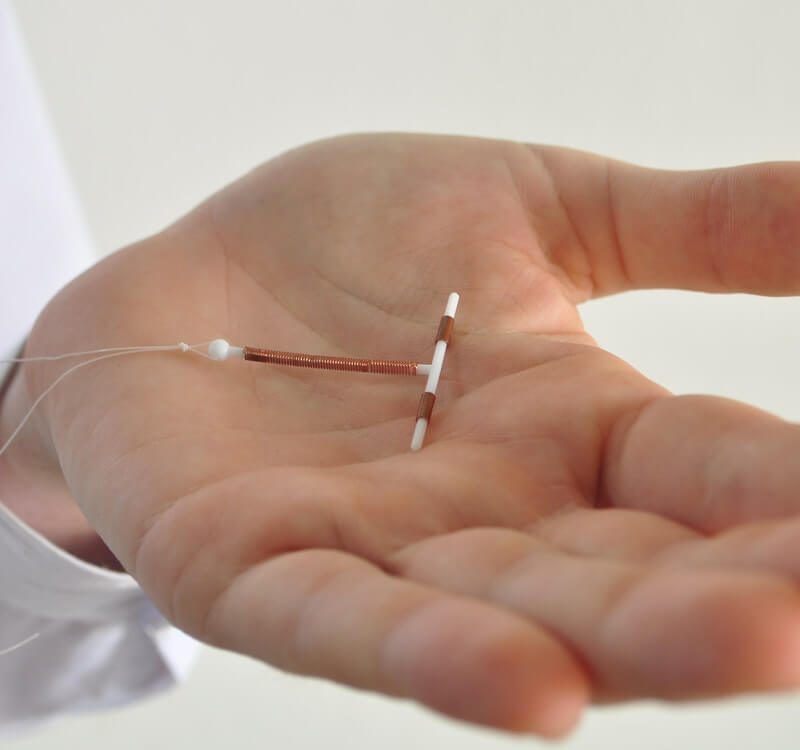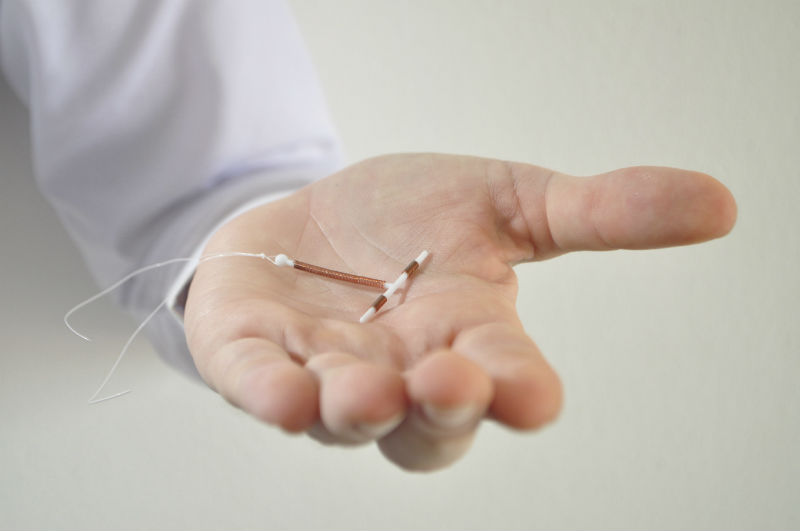Which one is right for you?
There are many options when it comes to contraceptives. You may have had an adverse reaction to one contraceptive and are looking for other methods. Here we share some contraception methods that may be a good option for you.
Spermicide
Spermicide is a contraceptive substance that immobilizes or kills sperm before they enter the uterus. This single-use applicator contains a spermicide gel. Spermicide can be used alone or with another barrier method – such as a condom, diaphragm, or cervical cap in order to prevent pregnancy.
Pros: Easy to use, inexpensive.
Cons: May make STDs more likely, and 29% get pregnant during the first year of use.
Phexxi
Phexxi works to prevent pregnancy by altering the pH of your vagina, which is different from hormonal birth control. It is a contraceptive vaginal gel that you insert with an applicator, similar to using a tampon. It can be inserted up to one hour before sex.
Pros: It’s easy to use and is about as effective as condoms, and you can use it with condoms for more protection. You can also use it with cervical caps and diaphragms.
Cons: Doesn’t protect against STDs and may irritate some people. Your insurance may not cover it.
Male Condom
A male condom is a thin sheath placed over an erect penis. When left in place during sexual intercourse, oral sex, or anal sex, male condoms are an effective way to protect yourself and your partner from sexually transmitted infections (STIs). Male condoms are also an effective way to prevent pregnancy.
Condoms, also called rubbers, are usually made of latex, but some are made from polyurethane or lambskin. Latex and polyurethane condoms provide the most protection against STIs.
Pros: Widely available, will protect against some STDs, inexpensive.
Cons: Effective only if used correctly every time. Male condoms can not be reused.
Female Condom
The female condom is also called an internal condom and is a birth control device that acts as a barrier to keep sperm from entering the uterus. It protects against pregnancy and sexually transmitted infections (STIs).
A female condom is generally a soft, loose-fitting pouch with a ring on each end. One ring is inserted into the vagina to hold the female condom in place. The ring at the open end of the condom remains outside the vagina. The outer ring helps keep the condom in place and is also used for removal.
Pros: Widely available, offers some protection against STDs.
Cons: Can be noisy, 21% of users get pregnant, and not reusable. Should not be used with a male condom to avoid breakage.
Diaphragm
The diaphragm is a birth control device that prevents sperm from entering the uterus. The diaphragm is a small, reusable rubber or silicone cup with a flexible rim that covers the cervix and must be fitted by a doctor. Before sex, the diaphragm is inserted deep into the vagina so that part of the rim fits snugly behind the pubic bone. The diaphragm is effective at preventing pregnancy only when used with spermicide.
Pros: Inexpensive.
Cons: No STD protection. Can’t be used during your period due to a risk of toxic shock syndrome.
Cervical Cap
The cervical cap is a contraceptive device that prevents sperm from entering the uterus. A cervical cap is a reusable, deep silicone cup that is inserted into the vagina and fits tightly over the cervix. When using a cervical cap, it is held in place by suction and has a strap to help with removal. The cervical cap is effective at preventing pregnancy only when used with spermicide. It must be fitted by a doctor.
This device, also called the FemCap, is similar to a diaphragm but smaller. It slips into place over the cervix. You use it with spermicide. About 15% of women who never had children get pregnant when using the cervical cap. About 30% of women who have had children get pregnant.
Pros: Can stay in place for 48 hours, inexpensive.
Cons: No protection against STDs. You can’t use it during your period.
Birth Control Sponge
The contraceptive sponge is a type of birth control that prevents sperm from entering the uterus. It is soft and disk-shaped and made of polyurethane foam. The contraceptive sponge contains spermicide, which blocks or kills sperm.
Before having sex, you insert the sponge deep inside the vagina so that it covers the cervix. Your vaginal muscles hold it in place. The contraceptive sponge has a strap on one side for easier removal.
Pros: No prescription, effective immediately.
Cons: Can be hard to put in. No STD protection. You can’t use it during your period.

Birth Control Pill
Combination birth control pills, also known as the pill, are oral contraceptives that contain estrogen and progestin.
“The Pill” is a combination birth control pill that keeps your ovaries from releasing an egg. They also cause changes in the cervical mucus and the lining of the uterus (endometrium) to keep sperm from joining the egg.
Different types of combination birth control pills contain different doses of estrogen and progestin. Continuous-dosing or extended-cycle pills allow you to reduce the number of periods you have each year.
Pros: Lighter, more regular periods or no periods, depending on the type. Less cramping.
Cons: No STD protection. May cause breast tenderness, spotting, blood clots, and raised blood pressure. Some women shouldn’t use it due to health risks.
Birth Control Patch
The birth control patch for women is a type of contraception that contains the hormones estrogen and progestin. You place the small patch on your skin once a week for three weeks, so that you wear a patch for a total of 21 days. During the fourth week, you don’t wear a patch – which allows menstrual bleeding to occur.
Birth control patches work similarly to combination birth control pills. The birth control patch prevents pregnancy by releasing hormones into your bloodstream that keep your ovaries from releasing an egg (ovulation). The birth control patch also thickens cervical mucus to keep sperm from reaching an egg.
You’ll need a prescription from your health care provider to use the birth control patch. The patch doesn’t protect against sexually transmitted infections (STIs).
Pros: Lighter, more regular periods with less cramping. No need to remember a daily pill.
Cons: May cause skin irritation or other side effects similar to birth control pills. No STD protection.
Vaginal Ring
The vaginal ring is a hormonal contraceptive device for women. A vaginal ring is a flexible, latex-free plastic ring that’s inserted into the vagina. It contains the hormones estrogen and progesterone, which are released over a three-week period. You wear the vaginal ring for three weeks, and then remove it – allowing menstruation to occur – and then insert a new ring after a week.
Similar to combination birth control pills, the vaginal ring prevents pregnancy by releasing hormones into your body. The hormones suppress ovulation – keeping your ovaries from releasing an egg.
Pros: Lighter, more regular periods. Less-frequent replacement.
Cons: May cause vaginal irritation or other side effects similar to pills and the patch. Doesn’t protect against STDs.
Birth Control Shot
A well-known brand name for medroxyprogesterone acetate is Depo-Provera, a contraceptive injection that contains the hormone progestin. Depo-Provera is given as an injection every three months. Depo-Provera typically suppresses ovulation, keeping your ovaries from releasing an egg. It also thickens cervical mucus to keep sperm from reaching the egg.
Medroxyprogesterone acetate is also available in a lower dosage. This version is called Depo-SubQ Provera 104. While Depo-Provera is injected deep into the muscle, Depo-SubQ Provera 104 is injected just beneath the skin.
Depo-Provera and Depo-SubQ Provera 104 have similar benefits and risks. To use Depo-Provera or Depo-SubQ Provera 104, you’ll need to visit your doctor or other healthcare provider.
Pros: Injected only 4 times per year, highly effective.
Cons: May cause spotting and other side effects. Doesn’t protect against STDs.
Birth Control Implant
Contraceptive implants are a long-term birth control option for women. A contraceptive implant is a flexible plastic rod about the size of a matchstick that is placed under the skin of the upper arm.
Nexplanon releases a low, steady dose of a progestational hormone to thicken cervical mucus and thin the lining of the uterus (endometrium). Contraceptive implants typically suppress ovulation as well.
Pros: Protects against pregnancy for 3 years and then must be removed. Highly effective.
Cons: May cause side effects, including irregular bleeding. Doesn’t protect against STDs.
IUD
IUD stands for intrauterine device. It is placed inside a woman’s uterus as a form of birth control. The non-hormonal copper IUD, ParaGard, works for as long as 10 years. The hormonal IUDs must be replaced after 3-5 years. Both types make it harder for sperm to fertilize the egg. Fewer than 8 in 1,000 women get pregnant.
Pros: Long-lasting, low-maintenance. Hormonal IUDs can make periods shorter and lighter.
Cons: Irregular or heavier periods. Copper IUDs may make periods more painful. You may experience side effects.
Tubal Ligation
Tubal ligation is also known as having your tubes tied or tubal sterilization; it is a type of permanent birth control. During a tubal ligation, the fallopian tubes are cut, tied, or blocked to permanently prevent pregnancy.
If you have a tubal ligation, it will prevent an egg from traveling from the ovaries through the fallopian tubes and blocks sperm from traveling up the fallopian tubes to the egg. The procedure doesn’t affect your menstrual cycle.
This procedure can be done at any time, including after childbirth or in combination with another abdominal surgery, such as a C-section. Most tubal ligation procedures cannot be reversed. If a reversal is attempted, it requires major surgery and isn’t always effective.
Pros: Permanent, nearly 100% effective.
Cons: Requires surgery, may not be reversible, expensive. Doesn’t protect against STDs.
Vasectomy
A vasectomy is a form of male birth control that cuts the supply of sperm in semen. It’s done by cutting and sealing the tubes that carry sperm. Vasectomy has a low risk of problems and can usually be performed in an outpatient setting under local anesthesia.
Although vasectomy reversals are possible, vasectomy should be considered a permanent form of male birth control.
Pros: Permanent, cheaper than tubal ligation, almost 100% effective.
Cons: Requires surgery, not effective immediately, may not be reversible. Doesn’t prevent STDs.
Emergency Contraception
Emergency contraceptives are usually used after sex to help avoid pregnancy. An emergency contraceptive is an option if you didn’t use contraception or if a woman suspects their usual method failed. There are lots of types to choose from, including brand-name pills or generic versions. There are emergency contraceptives available over the counter.
At OB-GYN Women’s Center, we are happy to discuss birth control options with you. We can provide you with the information so you can decide which option is right for you.




